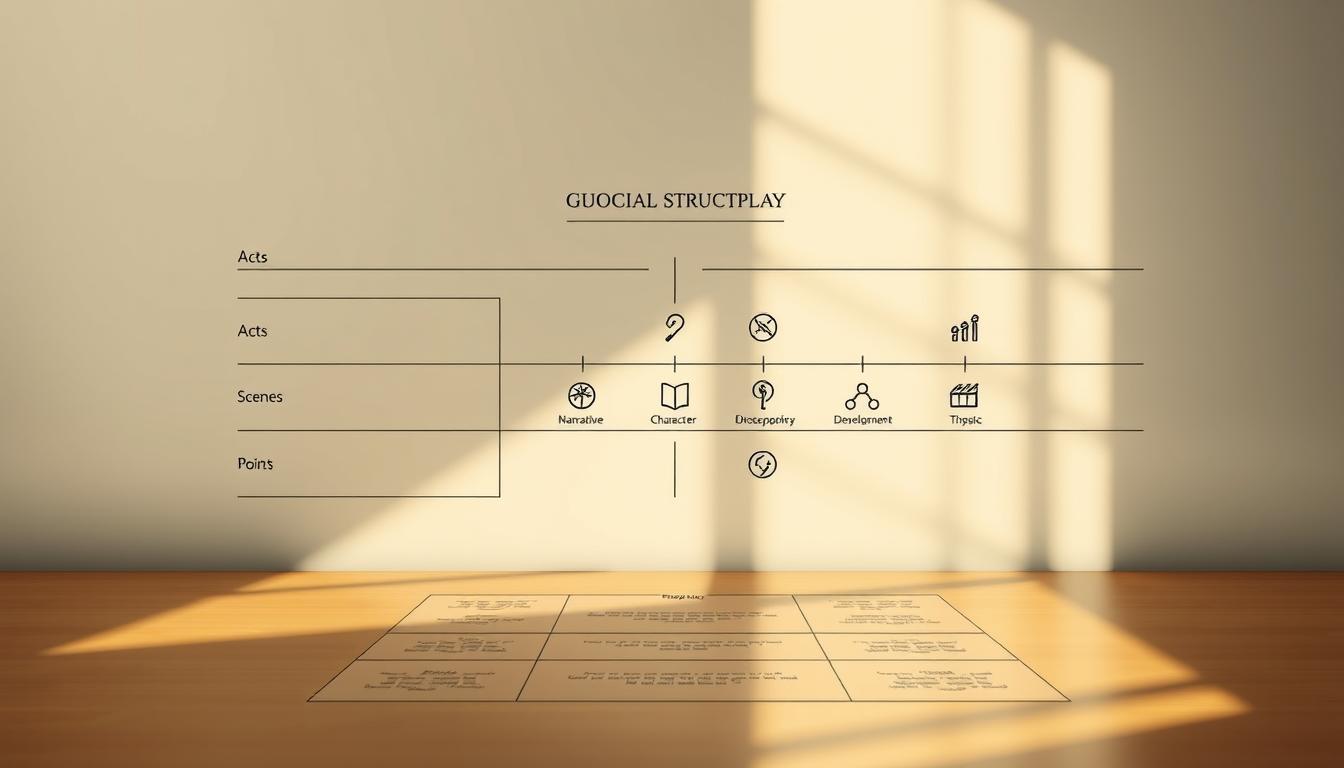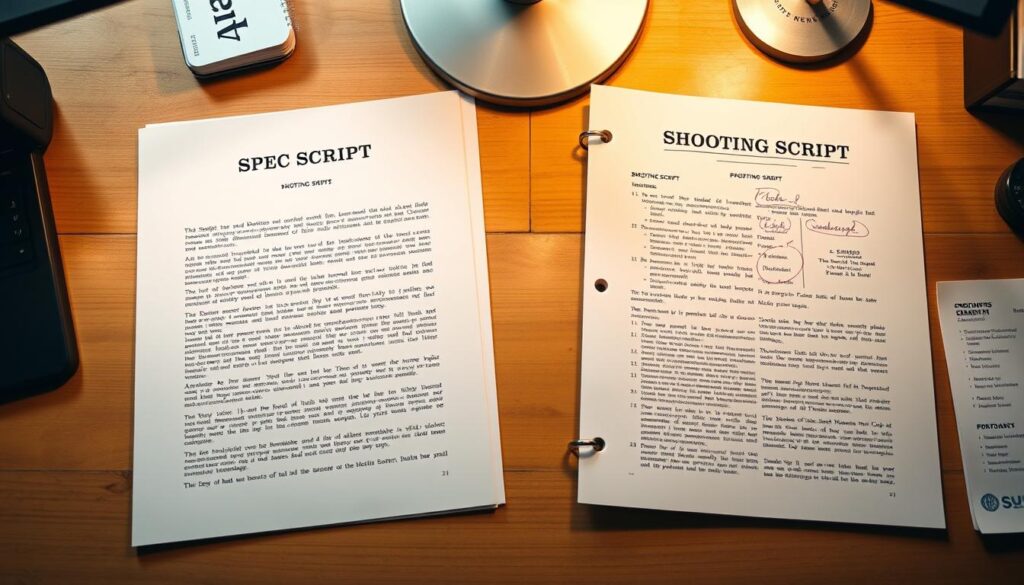Physical Address
304 North Cardinal St.
Dorchester Center, MA 02124
Physical Address
304 North Cardinal St.
Dorchester Center, MA 02124

Welcome to the art of cinematic storytelling. A screenplay is more than words on paper—it’s the backbone of every film. Whether you’re dreaming of Hollywood or indie projects, understanding industry standards transforms ideas into professional scripts. Let’s explore what makes this format unique.
Standard scripts use Courier 12pt font on 8.5″ x 11″ paper. One page equals roughly one minute of screen time. Comedies often hit 90 pages, while dramas stretch to 120. This structure isn’t arbitrary—it ensures clarity for directors, actors, and crews.
Formatting matters because it builds trust. Industry pros expect clean, precise documents. But don’t worry—rules exist to enhance creativity, not limit it. Your story’s heart remains central, supported by technical precision.
This guide simplifies the process. You’ll learn to balance artistic vision with practical requirements. From concept development to final edits, we’ll cover tools that make script creation accessible. No prior experience? Perfect. Let’s turn your ideas into compelling narratives.
Behind every memorable film lies a blueprint called a screenplay. This dynamic document bridges imagination and execution, serving as the roadmap for directors, actors, and crews. Unlike novels or stage plays, scripts prioritize visual storytelling—every word shapes what audiences ultimately see.
A script transforms ideas into actionable instructions. It might spring from original concepts or adapt existing works—novels, news articles, or real events. Think of it as architectural plans for a house: producers secure funding, directors visualize scenes, and actors embody characters using your words.
Great screenwriting thrives on clarity. Your descriptions guide set designers. Your dialogue informs actors’ deliveries. Even page margins matter—proper formatting lets crews scan documents quickly during hectic shoots.
Filmmaking is teamwork. Your story becomes a shared language for departments with different skills. Directors might reinterpret scenes. Actors add emotional layers. Your job? Create a foundation flexible enough for collaboration yet precise in its vision.
Effective scripts show rather than tell. Instead of lengthy inner monologues, they use visuals—a trembling hand, a slammed door. This approach keeps pacing tight and production feasible. Remember: your words launch a thousand creative interpretations.
Proper formatting transforms your script from rough draft to production-ready document. Margins act as invisible guides: 1″ for top, bottom, and right edges, with a 1.5″ left border. This asymmetrical design isn’t arbitrary—it creates space for brass fasteners while maintaining visual harmony on the page.
Every line stays single-spaced, whether describing action or crafting dialogue. This consistency helps crews estimate shooting schedules—one formatted page equals one minute of screen time. Your first page always starts with FADE IN: centered near the top. Notice the missing number? Page one never gets one.
Subsequent pages show numerals in the upper right corner—0.5″ from the top edge. These details matter more than you’d think. A properly numbered script lets directors flip quickly during rehearsals. Precise margins help producers calculate printing costs before greenlighting projects.
Formatting isn’t about stifling creativity. It’s the secret handshake that says “I speak your language” to industry pros. When your screenplay follows these rules, readers focus on your story instead of fixing layout errors. That extra half-inch on the left? It’s not just blank space—it’s the difference between “maybe” and “let’s shoot this.”
Transforming blank pages into cinematic gold isn’t for the faint-hearted. Crafting a script demands equal parts inspiration and elbow grease—you’re building worlds while wrestling structure, characters, and pacing. But here’s the secret pros know: that messy first draft is pure creative fuel.
Your initial version isn’t meant to dazzle. It’s clay waiting to be shaped. Industry veterans often rewrite scripts 5-7 times before filming. Why? Great stories emerge through subtraction—trimming flabby scenes, sharpening dialogue, deepening motivations. Think sculpting marble: chip away until the masterpiece appears.
Three truths every writer needs:
Characters make or break your script. Spend hours asking “Why?” about their choices. That bartender with the scar? She’s not set dressing—her backstory informs every pour. When dialogue feels flat, act it out loud. Your dog might judge you, but the lines will tighten.
Embrace the grind. Pulitzer winner Michael Chabon revised his novel 12 times. Your story deserves that devotion. With each pass, you’ll spot new ways to heighten conflict or streamline action. The magic happens when craft meets persistence.

Spec scripts and shooting scripts serve different masters in the film industry. One aims to captivate buyers, while the other guides production teams. Knowing which format to use—and when—could mean the difference between a script sale and a rejection letter.
A spec script is your golden ticket into Hollywood. Written without payment, it showcases your ability to craft marketable stories. These documents follow formatting rules religiously—no camera angles or editing notes. Why? Industry readers want pure storytelling, not unsolicited directing advice.
Deviating from standard margins or dialogue spacing marks you as an amateur. Studios receive thousands of submissions monthly. Proper structure helps your work stand out for the right reasons. Remember: your goal is to sell the script, not micromanage its filming.
Sold scripts evolve into shooting versions during pre-production. This transformed document gains scene numbers, transition notes, and technical directions. Color-coded pages track revisions—blue for dialogue tweaks, pink for new scenes.
New writers often sabotage themselves by adding production elements too early. That “zoom in” direction you love? Delete it. Shooting scripts handle those details later. Focus your writing on character arcs and crisp dialogue instead. Your future director will thank you.
Clear navigation separates polished scripts from amateur drafts. Scene headings act as road signs for production teams, answering two critical questions: Where and when does this moment unfold?
Sluglines demand military precision. Three elements rule their structure: location type (INT./EXT.), specific place, and time of day. Consider this example:
EXT. BROOKLYN BRIDGE – SUNSET
This tells crews they’re filming outdoors at a landmark during golden hour. Capitalization ensures instant recognition during hectic shoots. Avoid creative flourishes like “RAIN-SOAKED” or “ABANDONED”—let the action descriptions handle mood.
Subheaders work best for minor location shifts within larger scenes. Need characters to move from kitchen to backyard? Try:
BACKYARD
No need for full INT./EXT. labels here. But tread carefully—multiple subheaders per page scream “newbie.” Production designers prefer fewer, clearer markers over constant micro-changes.
Remember: every formatting choice serves the script‘s readability. Crews scan documents fast. Make their jobs easier, and your work climbs the priority list.

Dynamic scripts thrive on two pillars: what characters do and what they say. Action lines act as your camera lens, capturing visible details like a shattered teacup or distant police sirens. Write these in present tense, focusing strictly on observable elements—if audiences can’t see or hear it, delete it.
Effective action writing moves like a well-edited trailer. Three-line paragraphs become the maximum—anything longer slows production readers. Describe environments through character interactions instead of static details. A detective’s nicotine-stained fingers tapping a case file reveals more than three sentences about office decor.
Dialogue serves three masters simultaneously. Each spoken line should:
Format spoken words with precision. Off-screen conversations use (O.S.) notations, while voice-overs require (V.O.). When a bartender mutters under her breath during an argument, the action line “clenches bar rag” adds subtext to her terse reply.
The rhythm between action and dialogue dictates pacing. Long speeches demand physical business—a lawyer adjusting her tie mid-monologue. Rapid-fire exchanges benefit from sparse descriptions. Remember: white space on the page translates to breathing room on screen.
Memorable characters anchor cinematic stories through vivid first impressions. Their initial descriptions act as casting notices embedded in your script—concise yet revealing. Nail these moments, and your characters leap off the page into readers’ imaginations.
Introduce key players with capitalized names in action lines. For example:
A motorcycle engine ROARS. JASMINE (27), leather jacket frayed at the cuffs, kicks down the kickstand.
This format signals importance while delivering age, style, and attitude. Avoid laundry lists of traits—two vivid details spark more curiosity than six generic ones. A chef’s “knife-scarred thumb” reveals backstory; a CEO’s “mismatched socks” hints at hidden quirks.
Character names dominate dialogue sections through strategic formatting:
| Element | Main Character | Minor Role |
|---|---|---|
| Name Format | LIAM | BARISTA |
| Details Provided | Age, visual traits, personality hints | Role title only |
| Capitalization | First mention in action + dialogue headers | Dialogue headers only |
Smart naming avoids alphabet soup—different starting letters prevent confusion. MARTA and LENA work better than SARAH and SANDRA. This trick helps actors track roles during table reads.
Balanced introductions give directors flexibility. Describe a detective’s “permanent coffee stain on tie” rather than dictating exact wardrobe. Your characters become collaboration springboards—detailed enough to guide, open enough to inspire.
Every great film follows an invisible rhythm—the three-act structure shapes this pulse. This framework organizes your story into digestible beats while allowing room for creative surprises. Think of it as guardrails for imagination.
Your opening act introduces the characters’ ordinary world before disruption. Establish core relationships and plant the script’s central conflict within 15-20 pages. The inciting incident—a phone call, a missed train—propels protagonists into new territory.
This 60-page marathon tests your characters’ resolve. Escalating obstacles force growth—a shy teacher becomes a rebel leader. The midpoint shift separates Act Two’s halves. A betrayal or discovery here alters the story’s trajectory permanently.
Final scenes deliver emotional payoffs. Resolve the main conflict while leaving room for interpretation. A well-crafted ending makes audiences forget they’re watching a script—they’re living it.
Structure isn’t restrictive—it’s your development ally. Master this blueprint, and your creative process gains momentum. Now go shape worlds worth watching.